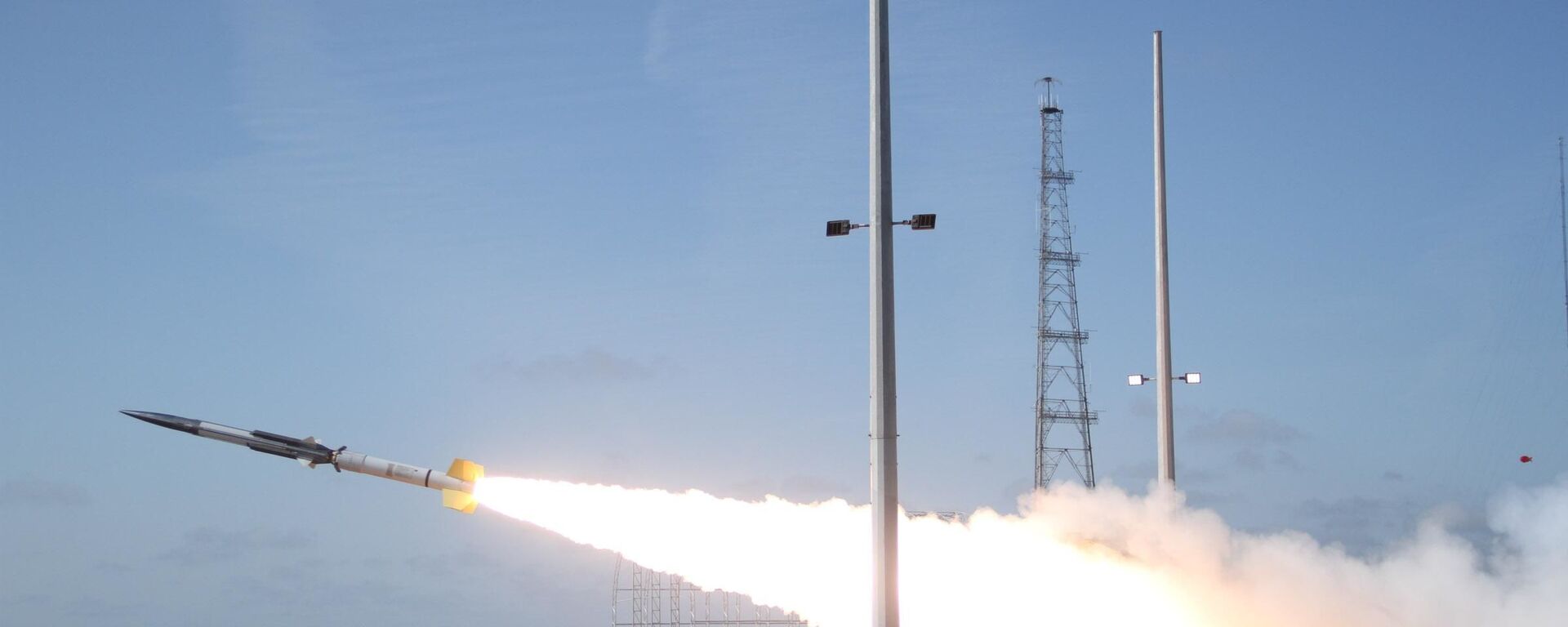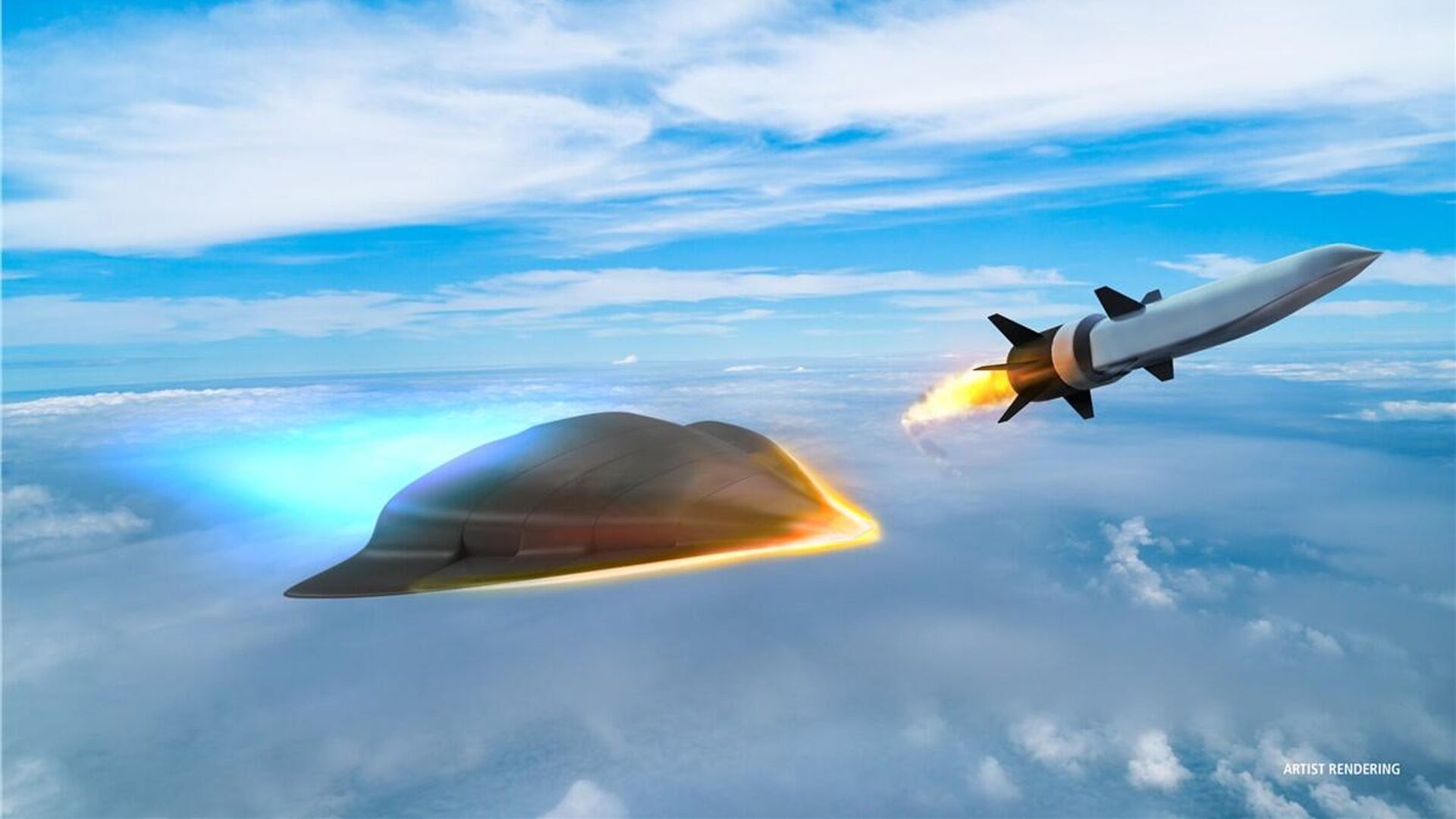https://sputnikglobe.com/20221028/ex-dod-officer-us-hypersonic-race-with-russia--china-wont-save-the-day-peace-talks-are-a-must-1102802409.html
Ex-DoD Officer: US Hypersonic Race With Russia & China Won't Save the Day, Peace Talks are a Must
Ex-DoD Officer: US Hypersonic Race With Russia & China Won't Save the Day, Peace Talks are a Must
Sputnik International
The US Navy and Army on October 26 conducted the High Operational Tempo for Hypersonics flight campaign by launching a precision sounding rocket containing... 28.10.2022, Sputnik International
2022-10-28T15:17+0000
2022-10-28T15:17+0000
2023-06-19T12:45+0000
americas
us
opinion
russia
ukraine
china
hypersonic
nuclear weapons
peace talks
taiwan
https://cdn1.img.sputnikglobe.com/img/07e6/07/13/1097586461_0:79:1200:754_1920x0_80_0_0_2441462d680d518474bc8086c964bd14.jpg
Delivering hypersonic weapons has become one of the Pentagon's highest priorities after China conducted supposed hypersonic launches in 2021 and Russia used hypersonic Kinzhal missiles for the first time on March 18, 2022 amid the special military operation to demilitarize and de-Nazify Ukraine.The joint Army-Navy hypersonic missile program has had a lot of test failures of late, according to David T. Pyne, an EMP Task Force scholar and former US Department of Defense officer.The Pentagon's Wednesday flight campaign was executed by Sandia National Laboratories (SNL) from the National Aeronautics and Space Administration (NASA) Wallops Flight Facility in Virginia. The sounding rocket launched by the US military contained hypersonic experiments from the Pentagon's defense contractors and partners, including the Navy’s Conventional Prompt Strike (CPS), the Missile Defense Agency (MDA), the Joint Hypersonic Transition Office, SNL, Johns Hopkins University/Applied Physics Laboratory, and Oak Ridge National Laboratory, to name but a few. This was the second test conducted under the program to develop US sea and land-based hypersonic capabilities. The first one was carried out in October 2021. At the same time, the MDA was tasked with developing systems that will defend against hypersonic weapons.Hypersonic arms are capable of flying at speeds greater than five times the speed of sound (Mach 5). They are also highly maneuverable and operate at varying altitudes to evade adversaries' air defense systems.US Still Lagging BehindAmerican military and civilian officials as well as lawmakers are well aware of the US lagging behind Russia and China in terms of hypersonic capabilities and countermeasures. In November 2021, Gen. David Thompson, vice chief of space operations, acknowledged that the Pentagon is "not as advanced as the Chinese or the Russians in terms of hypersonic programs," while speaking at the Halifax International Security Forum. Last week, Rep. Doug Lamborn (R-Colo.) cited the same issue at the Raytheon-sponsored conference "National Security at the Speed of Sound: Hypersonics in American Defense."To catch up with its competitors, the Pentagon requested $4.7 billion in the fiscal year 2023 budget, up from $3.8 billion the previous year, as per the October 2022 Congressional Research Service report.According to Pyne, the US leadership adopted a triumphalist approach after the end of the Cold War and subsequent collapse of the USSR and became lax, believing that it was not necessary to begin modernizing its nuclear arsenal until 2010. "This unfortunate and naïve mentality has caused the US to fall behind Russia and China in the area of nuclear hypersonic development," the former Pentagon officer stressed.The EMP Task Force scholar presumed that apart from the US leadership's lax approach to the nation's military modernization needs, the US hypersonic program could have been subjected to potential Chinese "cyber sabotage." However, it could be even easier than that. The US media reported last week that some American producers sold cutting-edge technology for hypersonic research to Chinese middlemen firms which did not even conceal relationships with China's weapons and military groups, including those blacklisted by Washington. To cap it all off, some of the aforementioned US producers have been the beneficiaries of US Defense Department grants.Arms Race vs Peaceful CoexistenceThe US hypersonic program's recent successes are unlikely to impact the present balance of power between the US-led Western alliance on the one side, and China and Russia on the other side, according to Pyne."The problem is that US hypersonic missile programs are currently designed to be armed with conventional warheads while Russian and Chinese hypersonic missile programs are designed to be dual-capable, but by default are meant to be armed with nuclear warheads," the former Pentagon officer noted. "Accordingly, unless the US were to arm them with nuclear warheads, which it could do without much difficulty, it is difficult to see how US conventionally-armed hypersonic warheads could contribute in any meaningful way in impacting the current balance of power."A hypersonic nuclear race is by no means the way to reshuffle the power balance and come to meaningful solutions, according to the EMP Task Force scholar.
https://sputnikglobe.com/20221026/us-army-navy-complete-hypersonic-weapon-tests-in-virginia---reports-1102742197.html
https://sputnikglobe.com/20221002/russian-hypersonic-missiles-superior-to-anything-natos-got-french-media-says-1101439924.html
americas
russia
ukraine
china
taiwan
Sputnik International
feedback@sputniknews.com
+74956456601
MIA „Rossiya Segodnya“
2022
News
en_EN
Sputnik International
feedback@sputniknews.com
+74956456601
MIA „Rossiya Segodnya“
Sputnik International
feedback@sputniknews.com
+74956456601
MIA „Rossiya Segodnya“
us, opinion, russia, ukraine, china, hypersonic, nuclear weapons, peace talks, taiwan
us, opinion, russia, ukraine, china, hypersonic, nuclear weapons, peace talks, taiwan
Ex-DoD Officer: US Hypersonic Race With Russia & China Won't Save the Day, Peace Talks are a Must
15:17 GMT 28.10.2022 (Updated: 12:45 GMT 19.06.2023) The US Navy and Army on October 26 conducted the High Operational Tempo for Hypersonics flight campaign by launching a precision sounding rocket containing over a dozen hypersonic experiments. The test was aimed at collecting data on the performance of materials and systems in a realistic hypersonic environment.
Delivering hypersonic weapons has become one of the Pentagon's highest priorities after China conducted
supposed hypersonic launches in 2021 and Russia used hypersonic Kinzhal missiles for the first time on March 18, 2022 amid the special military operation to demilitarize and de-Nazify Ukraine.
The joint Army-Navy hypersonic missile program has had a lot of test failures of late, according to David T. Pyne, an EMP Task Force scholar and former US Department of Defense officer.
"[This has] kept the US well behind Russia and China which both have operational nuclear hypersonic missile programs," Pyne told Sputnik. "It appears that both the US Navy’s Conventional Prompt Strike (CPS) and the Army’s Long Range Hypersonic Weapon (LRHW) are set to begin deployment next year."
The Pentagon's Wednesday flight campaign was executed by Sandia National Laboratories (SNL) from the National Aeronautics and Space Administration (NASA) Wallops Flight Facility in Virginia. The sounding rocket launched by the US military contained hypersonic experiments from the Pentagon's defense contractors and partners, including the Navy’s Conventional Prompt Strike (CPS), the Missile Defense Agency (MDA), the Joint Hypersonic Transition Office, SNL, Johns Hopkins University/Applied Physics Laboratory, and Oak Ridge National Laboratory, to name but a few. This was the second test conducted under the program to develop US sea and land-based hypersonic capabilities. The first one was carried out in October 2021. At the same time, the MDA was tasked with
developing systems that will defend against hypersonic weapons.
Hypersonic arms are capable of flying at speeds greater than five times the speed of sound (Mach 5). They are also highly maneuverable and operate at varying altitudes to evade adversaries' air defense systems.

26 October 2022, 21:38 GMT
American military and civilian officials as well as lawmakers are well aware of the US lagging behind Russia and China in terms of hypersonic capabilities and countermeasures. In November 2021, Gen. David Thompson, vice chief of space operations, acknowledged that the Pentagon is "not as advanced as the Chinese or the Russians in terms of hypersonic programs," while speaking at the Halifax International Security Forum. Last week, Rep. Doug Lamborn (R-Colo.) cited the same issue at the Raytheon-sponsored conference "National Security at the Speed of Sound: Hypersonics in American Defense."
To catch up with its competitors, the Pentagon requested $4.7 billion in the fiscal year 2023 budget, up from $3.8 billion the previous year, as per the October 2022 Congressional Research Service report.
According to Pyne, the US leadership adopted a triumphalist approach after the end of the Cold War and subsequent collapse of the USSR and became lax, believing that it was not necessary to begin modernizing its nuclear arsenal until 2010. "This unfortunate and naïve mentality has caused the US to fall behind Russia and China in the area of nuclear hypersonic development," the former Pentagon officer stressed.
"While the US is set to operationally deploy its first hypersonic missiles next year followed by hypersonic-glide vehicles similar to the ones used by the Chinese DF-ZF and the Russian Avangard, it will likely take years for the US to catch up to Russia and China in terms of the numbers of hypersonic missile systems they have deployed," Pyne said.
The EMP Task Force scholar presumed that apart from the US leadership's lax approach to the nation's military modernization needs, the US hypersonic program could have been subjected to potential Chinese "cyber sabotage." However, it could be even easier than that. The US media reported last week that some American producers sold cutting-edge technology for hypersonic research to Chinese middlemen firms which did not even conceal relationships with China's weapons and military groups, including those blacklisted by Washington. To cap it all off, some of the aforementioned US producers have been the beneficiaries of US Defense Department grants.

2 October 2022, 13:48 GMT
Arms Race vs Peaceful Coexistence
The US hypersonic program's recent successes are unlikely to impact the present balance of power between the US-led Western alliance on the one side, and China and Russia on the other side, according to Pyne.
"The problem is that US hypersonic missile programs are currently designed to be armed with conventional warheads while Russian and Chinese hypersonic missile programs are designed to be dual-capable, but by default are meant to be armed with nuclear warheads," the former Pentagon officer noted. "Accordingly, unless the US were to arm them with nuclear warheads, which it could do without much difficulty, it is difficult to see how US conventionally-armed hypersonic warheads could contribute in any meaningful way in impacting the current balance of power."
A hypersonic nuclear race is by no means the way to reshuffle the power balance and come to meaningful solutions, according to the EMP Task Force scholar.
"The way that US leaders should focus on pursuing to alter the current balance of power is to suspend lethal military assistance to Ukraine, pressuring Kiev to agree to a cease fire and negotiate a reunification agreement between the PRC and Taiwan," Pyne underscored. "Then we can negotiate a sphere of influence agreement with Russia and China enabling us to end the threat of nuclear war which would destroy all three nuclear superpowers, so we can peacefully coexist with each other."




